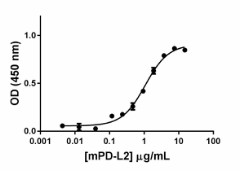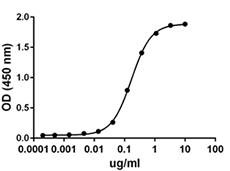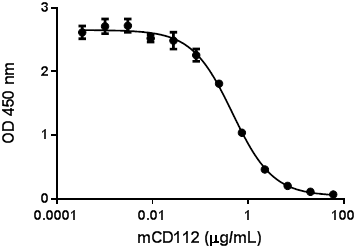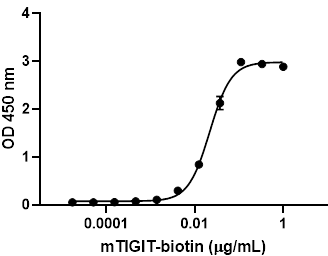- Regulatory Status
- RUO
- Other Names
- CD273, Programmed cell death 1 ligand 2 (PD-L2), B7 dendritic cell molecule (B7-DC), Butyrophilin B7-DC, PDCD1 Ligand 2
- Ave. Rating
- Submit a Review
- Product Citations
- publications

-

Recombinant mouse PD-L2 binds mouse PD-1 in a dose dependent manner. The ED50 for this effect is 0.5 - 2.5 µg/ml. -

Stability testing for Mouse PD-L2/ CD273-Fc Chimera. Mouse PD-L2 was aliquoted in DPBS at 0.2 mg/mL; one aliquot was kept at 4°C (control) and another was frozen and thawed four times (4X Freeze/thaws). After this procedure, the samples were tested by binding assay. Mouse recombinant PD-L2 binds recombinant mouse PD-1 in a dose dependent manner.
PD-L2 is a type I transmembrane protein of 247 amino acids, and it is a member of the B7 family. Mouse PD-L2 has 70% amino acid identity to its human orthologue. PD-L2 is the second ligand for PD-1, and its binding to PD-1 leads to the inhibition of T cell receptor–mediated lymphocyte proliferation and cytokine secretion. PD-L2/PD-1 interaction suppresses immune responses against autoantigens and tumors and plays an important role in the maintenance of peripheral immune tolerance. Antibody blocking of PD-L2 on dendritic cells results in enhanced T cell proliferation and cytokine production. Interaction of PD-1 by PD-L1-Ig or PD-L2-Ig fusion protein has an inhibitory effect on proliferation and cytokine production during anti-CD3-mediated stimulation. PD-L2 is expressed in biopsies from human asthmatics and lungs of aeroallergen-treated mice and its expression correlates with the asthma severity. In vivo blockade of PD-L2 reduces the severity of allergen-driven airway hyperresponsiveness (AHR). Blockage of PD-L2 induces IL-12 production by DC; IL-12 may limit the severity of allergen-induced AHR antagonizing IL-13. In addition, blockade of PD-1 does not have an effect on AHR; therefore, PD-L2 controls asthma severity in a PD-1 independent manner. PD-L2 binds to a second receptor, RGMb (repulsive guidance molecule b) which is expressed in lung interstitial macrophages and alveolar epithelial cells and is a co-receptor for bone morphogenetic proteins BMP2/4. Blockade of the RGMb/PD-L2 interaction significantly impairs the development of respiratory tolerance since the initial T cell expansion is inhibited.
Product DetailsProduct Details
- Source
- Mouse PD-L2, amino acids (Leu20-Arg219) (Accession # NP_067371) was expressed in 293E cells. The carboxyl-terminus contains a linker-IgG Fc.
- Molecular Mass
- The 439 amino acid recombinant protein has a predicted molecular mass of approximately 49.4 kD. The DTT-reduced and non-reduced protein migrate at approximately 70 kD and 140 kD respectively by SDS-PAGE. The predicted N-terminal amino acid is Leu.
- Purity
- > 95% by SDS-PAGE gel as determined by Coomassie stained SDS-PAGE and HPLC analyses.
- Formulation
- 0.22 µm filtered protein solution is in DPBS pH 6.8.
- Endotoxin Level
- Less than 0.10 EU per µg of protein as determined by the LAL method.
- Concentration
- 10 and 25 µg sizes are bottled at 200 µg/mL. 100 µg size and larger sizes are lot-specific and bottled at the concentration indicated on the vial. To obtain lot-specific concentration and expiration, please enter the lot number in our Certificate of Analysis online tool.
- Storage & Handling
- Unopened vial can be stored between 2°C and 8°C for up to 2 weeks, at -20°C for up to six months, or at -70°C or colder until the expiration date. For maximum results, quick spin vial prior to opening. The protein can be aliquoted and stored at -20°C or colder. Stock solutions can also be prepared at 50 - 100 µg/mL in appropriate sterile buffer, carrier protein such as 0.2 - 1% BSA or HSA can be added when preparing the stock solution. Aliquots can be stored between 2°C and 8°C for up to one week and stored at -20°C or colder for up to 3 months. Avoid repeated freeze/thaw cycles.
- Activity
- The bioactivity was measured by functional ELISA. Recombinant mouse PD-L2 binds mouse PD-1 in a dose dependent manner. The ED50 = 0.5 - 2.5 µg/mL.
- Application
-
Bioassay
- Additional Product Notes
-
BioLegend carrier-free recombinant proteins provided in liquid format are shipped on blue ice. Our comparison testing data indicates that when handled and stored as recommended, the liquid format has equal or better stability and shelf-life compared to commercially available lyophilized proteins after reconstitution. Our liquid proteins are verified in-house to maintain activity after shipping on blue ice and are backed by our 100% satisfaction guarantee. If you have any concerns, contact us at tech@biolegend.com.
Antigen Details
- Structure
- Dimer
- Distribution
-
Immature dendritic cells, mature dendritic cells, subset of macrophages, placental endothelium, and medullary thymic epithelial cells.
- Function
- Inhibits T cell mediated proliferation and cytokine production by CD4+ T cells. Regulate T cell responses. PD-L2 expression is up-regulated on antigen-presenting cells by IFNg.
- Interaction
- Antigen-stimulated T and B cells, regulatory T cells, follicular T and B cells, dendritic cells, and monocytes.
- Ligand/Receptor
- PD-1 (CD279), RGMb.
- Bioactivity
- Recombinant mouse PD-L2 binds PD-1.
- Cell Type
- Dendritic cells, Endothelial cells, Epithelial cells, Macrophages
- Biology Area
- Immunology
- Molecular Family
- CD Molecules, Immune Checkpoint Receptors, Soluble Receptors
- Antigen References
-
- Latchman Y, et al. 2001. Nat. Immunol. 2:261.
- Brown JA, et al. 2003. J. Immunol. 170:1257.
- Youngnak P, et al. 2003. Biochem. Biophys. Res. Commun. 307:672.
- Singh AK, et al. 2011. Allergy. 66:155.
- Lewkowich IP, et al. 2013. Mucosal Immunol. 6:728.
- Xiao Y, et al. 2014. J. Exp. Med. 211:943.
- Bardhan K, et al. 2016. Front Immunol. 7:550.
- Gene ID
- 58205 View all products for this Gene ID
- UniProt
- View information about PD-L2 on UniProt.org
Related FAQs
- Why choose BioLegend recombinant proteins?
-
• Each lot of product is quality-tested for bioactivity as indicated on the data sheet.
• Greater than 95% Purity or higher, tested on every lot of product.
• 100% Satisfaction Guarantee for quality performance, stability, and consistency.
• Ready-to-use liquid format saves time and reduces challenges associated with reconstitution.
• Bulk and customization available. Contact us.
• Learn more about our Recombinant Proteins. - How does the activity of your recombinant proteins compare to competitors?
-
We quality control each and every lot of recombinant protein. Not only do we check its bioactivity, but we also compare it against other commercially available recombinant proteins. We make sure each recombinant protein’s activity is at least as good as or better than the competition’s. In order to provide you with the best possible product, we ensure that our testing process is rigorous and thorough. If you’re curious and eager to make the switch to BioLegend recombinants, contact your sales representative today!
- What is the specific activity or ED50 of my recombinant protein?
-
The specific activity range of the protein is indicated on the product datasheets. Because the exact activity values on a per unit basis can largely fluctuate depending on a number of factors, including the nature of the assay, cell density, age of cells/passage number, culture media used, and end user technique, the specific activity is best defined as a range and we guarantee the specific activity of all our lots will be within the range indicated on the datasheet. Please note this only applies to recombinants labeled for use in bioassays. ELISA standard recombinant proteins are not recommended for bioassay usage as they are not tested for these applications.
- Have your recombinants been tested for stability?
-
Our testing shows that the recombinant proteins are able to withstand room temperature for a week without losing activity. In addition the recombinant proteins were also found to withstand four cycles of freeze and thaw without losing activity.
- Does specific activity of a recombinant protein vary between lots?
-
Specific activity will vary for each lot and for the type of experiment that is done to validate it, but all passed lots will have activity within the established ED50 range for the product and we guarantee that our products will have lot-to-lot consistency. Please conduct an experiment-specific validation to find the optimal ED50 for your system.
- How do you convert activity as an ED50 in ng/ml to a specific activity in Units/mg?
-
Use formula Specific activity (Units/mg) = 10^6/ ED50 (ng/mL)

 Login / Register
Login / Register 













Follow Us